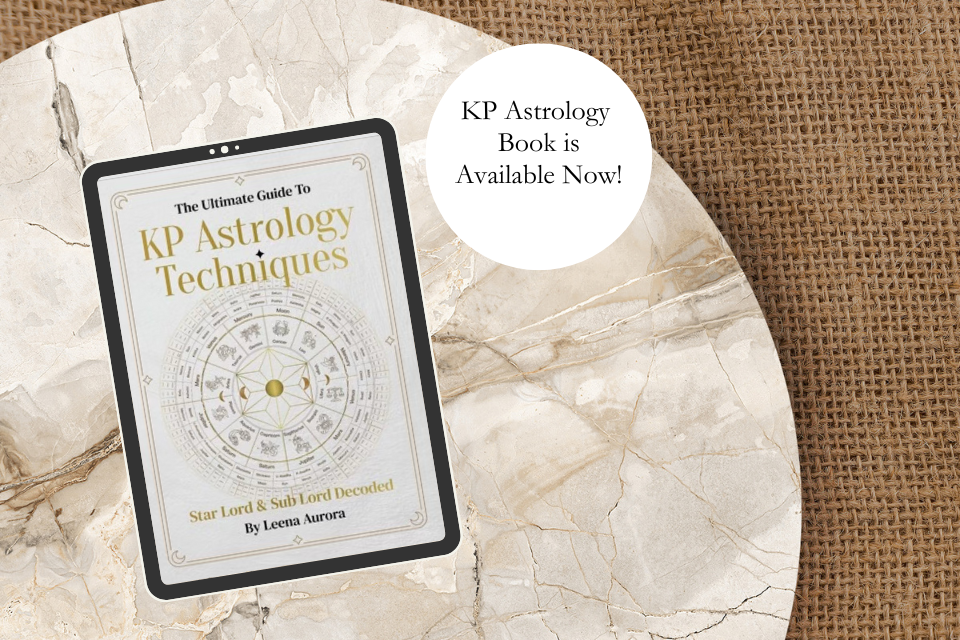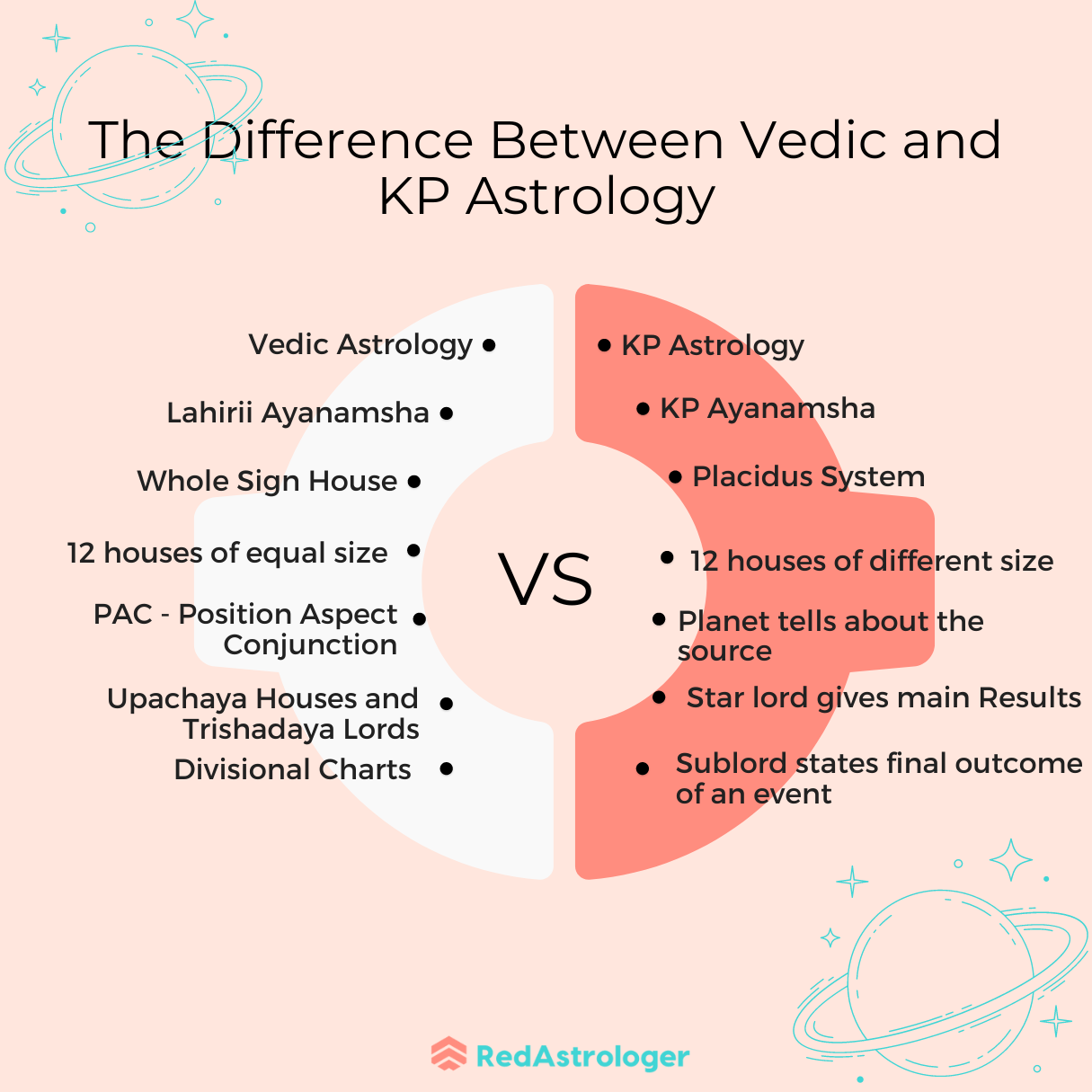Table of Contents
I recently met a girl who was fascinated by my KP Astrology book but was confused about how it differs from Vedic astrology, Western astrology, or even Lal Kitab. If you have the same confusion or have never heard of KP Astrology, read this article until the end.
KP Astrology is derived from the Vedic Astrology, utilizing the nine planets and twelve houses. It has further fine-tuned the method of deriving houses known as cusps.

In Vedic astrology, a planet rules each house which is 30 degrees. These houses are further co-owned by Nakshatras. Therefore a planet when placed in a house or a sign will be placed in one of the stars as per its current location.
| Lords | # | Star | # | Star | # | Star |
| Ketu | 1 | Ashwini | 10 | Magha | 19 | Moola |
| Venus | 2 | Bharani | 11 | Poorva Phalguni | 20 | Purvashadha |
| Sun | 3 | Kritika | 12 | Uttar Phaguni | 21 | Uttarashadha |
| Moon | 4 | Rohini | 13 | Hasta | 22 | Sravana |
| Mars | 5 | Mrigashira | 14 | Chitra | 23 | Dhanistha |
| Rahu | 6 | Ardra | 15 | Swati | 24 | Shatbhisha |
| Jupiter | 7 | Punarvasu | 16 | Vishakha | 25 | Poorvabhadrapada |
| Saturn | 8 | Pushya | 17 | Anuradha | 26 | Uttarabhadrapada |
| Mercury | 9 | Ashlesha | 18 | Jyeshta | 27 | Revati |
KP Astrology followers worship Shri Krishna Murti Ji founder of KP Astrology as God
Difference between Vedic and KP Astrology
The Vedic Astrology concept is that a planet in the house gives the result of the 3 stars allocated to the house. Here the house and 3 stars are fixed due to the equal house concept. Here the cusp starts at 0 and ends at 30 degrees. We see planets in the Lagna chart but to check the strength we have to see various divisional charts.
In Vedic Astrology, the house and the lords give results whereas in KP the cusp house, its star lord, and sub lord give results. So while analyzing a horoscope a planet is as powerful or weak as its star. But at times there are 3 planets in the same star, nonetheless, they give different results.
The KP system has adopted a Placidus system of house division. The range of a house could be less than 30 degrees and hence the sign linked with the cusp will be restricted to the span of the house at times a sign may be completely missing or two houses may have the same signs. Here the houses are calculated as per the signs calculated by the Placidus system. This is the main difference between the Vedic and the KP system.
According to Prof. K.S. Krishnamurti the Ascendant and cusp of the houses move faster than the planets. It is the ascendants and cusp of houses that describe such fast changes. through the relative position among planets and their ownership of the star and sub remain the same.

Difference between Western and KP Astrology
Western astrology uses the tropical zodiac, which is based on the Earth’s seasons and aligns the signs with the solstices and equinoxes. Western astrology typically focuses on broader planetary aspects and transits, which may not delve into the same level of detail.
KP astrology (Krishnamurti Paddhati) uses the Placidus system. While the Placidus system accounts for the Earth’s oblate shape, resulting in unequal house sizes. In this system, each of the twelve houses is divided into unequal segments, due to this a bhav chalit chart is formed, where some signs are missing and some are repeated.
KP astrology is known for its detailed approach using sub-lords to predict events. This technique involves breaking down planetary influences into nine sub-divisions to provide more accurate predictions about specific events.
Why Western and Vedic Astrologers Should Study KP Astrology
Western Astrology uses transits, progressions, and solar arc directions, which can offer insights but may not be as good at predicting specific events as KP astrology. Western astrology may focus more on general trends and psychological insights rather than pinpointing exact events.
Vedic Astrology offers a deeply spiritual and comprehensive analysis of a person’s life. It incorporates the concepts of Dharma, Artha, Kama, and Moksha, providing guidance not just for worldly matters but also for spiritual growth.
Lal Kitab is well-known for its practical and straightforward remedies to reduce the negative effects of planets. These remedies are often easy to perform and are designed to bring quick relief from specific problems. (Do not perform remedies on your own)
KP astrology follows a unique timing technique that states if an event is promised by the cusp and both the Maha Dasha and Antar Dasha support the event with favourable KP Combinations, then one can accurately predict the timing of that life event. The best part is that we can make positive use of KP combinations, and this makes it more helpful and brings self-awareness.
Therefore the KP House System is designed to provide more accurate and precise results, especially for event prediction and timing, by focusing on the exact cusps of the houses and their sub-lords. This system is integral to the KP method’s approach to astrology and is part of what differentiates it from other astrological systems.
KP Astrology: What is Star-Lord & Sub Lord
Star-Lord
The natural zodiac consists of 360 degrees of ecliptic path, and this further is divided into 12 houses of 30 degrees. It is additionally divided into 27 divisions of 13 degrees and 20 minutes. These divisions are known as Nakshatras or Stars.
Each house is 30 degrees and is divided into 3 parts as each star gets 13 deg and 20 min out of 360 degrees. Hence each house is allocated 2 and 1/4 stars. For example in the Aries sign, Ashwani, Bharani, and Kritika, 3 nakshatras or stars will be included. And further, each star has four padas or charan, and each pada is 3 degrees 20 minutes.
According to the KP (Krishnamurthy Paddhati) system, the results given by planets are determined by the houses they own and where their star lord is placed.
There are favourable and unfavourable KP combinations based on the houses and the position of the star lord in the cusp chart. These combinations help in determining the impact and influence of planets on various aspects of life as per KP astrology principles.
Sub-Lord
According to the KP system, a star is in the range of 13 degrees and 20 minutes. These 13 degrees and 20 minutes are further divided into nine subdivisions. These subdivisions are called sub-lords. The span of these subdivisions is in proportion to the Dasha years that are allocated to planets as per Vimshottari Dasha.
KP uses the star lord and the sub-lord to predict events in different spheres of life. The sub-lord changes very fast, this makes the chart show different coordinators due to the variation of a few minutes. Shri K.S. innovated the concept of dividing these stars into nine subdivisions. Therefore these subdivisions play a significant role in KP Astrology.
It is the cusp and cusp alone that emits the matters and it is the sub lord of the significator of a cusp that decides the favorable or success of matter and it is the Cuspal sub lord of the respective cusps that reveal and promise the quantum of the matters of the particular cusp.
Shri K.S. Krishnamurti.
Which Type of Astrology is more Accurate
Each system offers something unique:
• Vedic Astrology provides a spiritual and comprehensive view of life.
• KP Astrology is unmatched in the precision and timing of predictions.
• Lal Kitab is practical with its simple and effective remedies.
• Western Astrology offers deep psychological insights and personality analysis.
Depending on your needs—whether it’s spiritual guidance, precise predictions, practical remedies, or self-understanding—each system has its own best aspect to offer.


